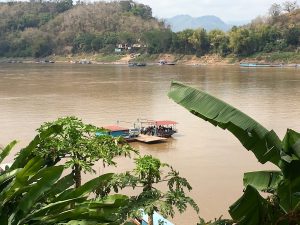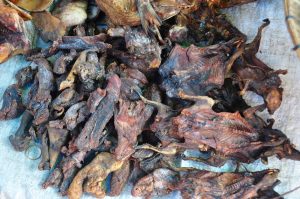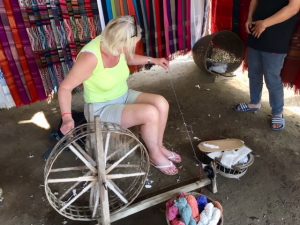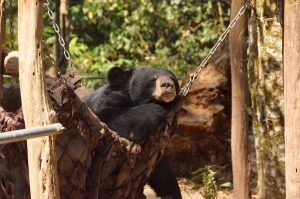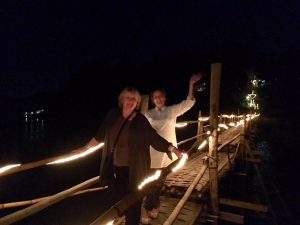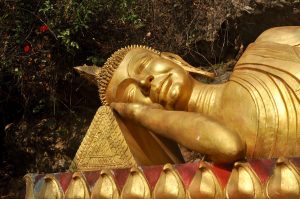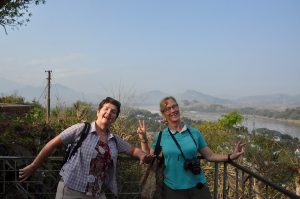If Hanoi and Ho Chi Minh City in Vietnam are considered to be fairly frenetic and Siem Reap is fairly placid, then Luang Prabang in Laos is positively horizontal in a laidback kind of way.
We were met at the airport by Phai, pronounced pie, our guide for this part of the trip, and taken on a short journey into Luang Prabang. For the first time we were transported in two minibuses, instead of a larger coach, separating at least half the group from the guide. Our hotel, Villa Saykham, was in the heart of Luang Prabang. The reception area was not particularly welcoming but once we passed through to the garden and the rooms, which were on two levels, it looked a lot better.
Once we had settled we ventured out to see if we could find somewhere to eat. We went thinking that we might have to split up as it would be unlikely that anywhere at a busy time of evening would be able to accommodate 21hungry people. It was also important that we changed some money, for Laos, unlike Cambodia, preferred the use of its own currency rather than dollars, and charged a tax whenever dollars were used.
Eventually, I found a restaurant and popped in to see if they could accommodate us, but as it was quite busy I was not holding out much hope. Remarkably they could. That would never happen in the UK.
The bulk of the town of Luang Prabang, which reminds me a little of a traditional French hill/riverside village, is sandwiched between the mighty Mekong River and the looping tributary, Nam Khan River. It means that everything is very close and easily accessible. Many of the buildings are built to the French villa design with lots of timber, balconies and pantile roofs. There was an air of affluence about the place and that was displayed best by the vehicles that people drove. There were no old cars, or even small cars. Everybody seemed to be driving new large pick-ups and people carriers.
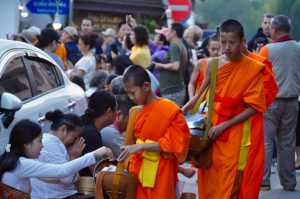 The following morning, I got up early when I heard the monastery bell ringing a couple of houses down from our hotel. At 6.00am the monks walk in a silent line receiving alms from the local people. They in turn distribute some of the food given to them to children kneeling down on mats along the route. They all have cardboard boxes or plastic bags to receive the gifts. Roads are closed off for the spectacle and tourists have to abide by certain rules. They must not get too close, they must be quiet during the procession and must wear appropriate clothes so that their knees and shoulders are covered. While some kept a respectable distance from the monks, there were some who took liberties with the gentle nature of the monks, pointing cameras in their faces, walking alongside them as if they were trying to get a reaction from them, and at the same time spoiling it for those keeping a respectable distance for their photographs.
The following morning, I got up early when I heard the monastery bell ringing a couple of houses down from our hotel. At 6.00am the monks walk in a silent line receiving alms from the local people. They in turn distribute some of the food given to them to children kneeling down on mats along the route. They all have cardboard boxes or plastic bags to receive the gifts. Roads are closed off for the spectacle and tourists have to abide by certain rules. They must not get too close, they must be quiet during the procession and must wear appropriate clothes so that their knees and shoulders are covered. While some kept a respectable distance from the monks, there were some who took liberties with the gentle nature of the monks, pointing cameras in their faces, walking alongside them as if they were trying to get a reaction from them, and at the same time spoiling it for those keeping a respectable distance for their photographs.
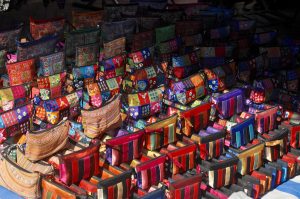 Breakfast was taken in the garden, after which Phai came to collect us for our day’s activities. The two minibuses transported us round the corner to visit the National Museum, housed in the former royal palace. It would have been quicker to walk, and a lot more interesting, as the main street was a colourful market with stalls on either side displaying their goods immaculately. I would have appreciated more time to walk among the stalls, enjoying a little bit of banter with the stallholders, rather than always bypassing them, which I felt was a little rude.
Breakfast was taken in the garden, after which Phai came to collect us for our day’s activities. The two minibuses transported us round the corner to visit the National Museum, housed in the former royal palace. It would have been quicker to walk, and a lot more interesting, as the main street was a colourful market with stalls on either side displaying their goods immaculately. I would have appreciated more time to walk among the stalls, enjoying a little bit of banter with the stallholders, rather than always bypassing them, which I felt was a little rude.
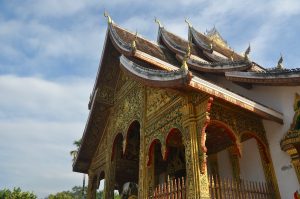 As interesting as the museum was, I was more interested in the human stories surrounding the royal family. Inevitably Laos was affected by the chaos of Indochina, was invaded by Vietnam and subjected to constant bombing by the Americans. This created a great deal of instability in the country and the communists gained strength. On Dec. 2nd 1975 King Savang Vatthana was forced to abdicate and he and other members of the royal family were arrested and sent to special re-education camps, where most eventually died. Some did manage to escape before they were arrested and ended up living in France. The royal family were not the only ones to suffer in this way. Between 30,000 and 40,000 were sent to these camps. Phai would not say much about this so I could not find out what format the re-education took, but I can assume it was no holiday camp!
As interesting as the museum was, I was more interested in the human stories surrounding the royal family. Inevitably Laos was affected by the chaos of Indochina, was invaded by Vietnam and subjected to constant bombing by the Americans. This created a great deal of instability in the country and the communists gained strength. On Dec. 2nd 1975 King Savang Vatthana was forced to abdicate and he and other members of the royal family were arrested and sent to special re-education camps, where most eventually died. Some did manage to escape before they were arrested and ended up living in France. The royal family were not the only ones to suffer in this way. Between 30,000 and 40,000 were sent to these camps. Phai would not say much about this so I could not find out what format the re-education took, but I can assume it was no holiday camp!
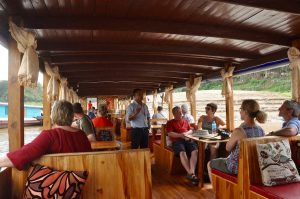 After we had finished our tour the minibuses took us round the corner to the Mekong River where a very long boat was waiting for us. Again, it would have been easier to walk the short distance to the river.
After we had finished our tour the minibuses took us round the corner to the Mekong River where a very long boat was waiting for us. Again, it would have been easier to walk the short distance to the river.
Once aboard we set off on a two-and-a-half-hour cruise up river. It was very spaciously comfortable with tables and chairs, coffee, a fore deck and an aft deck, and a driver who looked to be only a teenager. It was a brilliant way to experience the Mekong, one of those iconic rivers that came up in many a school geography lesson in the 60s. Here I was taking a ride on the Mekong – another pinch me moment.
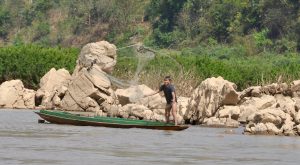 The flow on the river was quite fast but, fortunately, there was plenty of power in our boat’s engine, allowing us to scythe our way up stream. There was not a great deal of traffic on the river but there was plenty to see. On the banks fishermen’s shelters, stilted, thatched, open-sided structures, where they could sort their catch, mend their nets, store their canoes or just chill out when the day’s work is done. These are temporary structures, for during the rainy season the water levels are much higher, and the tiered, sandy beaches are under water. Naked children played in the shallows, cattle came down for a drink. On the river, monks travelled in a canoe near the shore, fishermen plied their way up, down and across looking for somewhere to cast their nets. Others stood, well balanced, in their canoes and deftly cast their nets in the hope of lifting it full of fish.
The flow on the river was quite fast but, fortunately, there was plenty of power in our boat’s engine, allowing us to scythe our way up stream. There was not a great deal of traffic on the river but there was plenty to see. On the banks fishermen’s shelters, stilted, thatched, open-sided structures, where they could sort their catch, mend their nets, store their canoes or just chill out when the day’s work is done. These are temporary structures, for during the rainy season the water levels are much higher, and the tiered, sandy beaches are under water. Naked children played in the shallows, cattle came down for a drink. On the river, monks travelled in a canoe near the shore, fishermen plied their way up, down and across looking for somewhere to cast their nets. Others stood, well balanced, in their canoes and deftly cast their nets in the hope of lifting it full of fish.
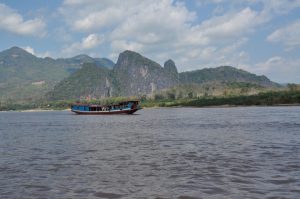 All the time a stunning landscape rose up from the river, of shapely mountains that just begged to be explored. Most were forested, but as we ventured further upstream they became more dramatic with large rocky outcrops more reminiscent of the karst scenery we had seen in Vietnam. The guide book suggests that the outline of the ridge looks like a vast green eagle taking off. I didn’t see it at the time and, having studied my photographs of the ridge, I still don’t see it. I was really enjoying this trip.
All the time a stunning landscape rose up from the river, of shapely mountains that just begged to be explored. Most were forested, but as we ventured further upstream they became more dramatic with large rocky outcrops more reminiscent of the karst scenery we had seen in Vietnam. The guide book suggests that the outline of the ridge looks like a vast green eagle taking off. I didn’t see it at the time and, having studied my photographs of the ridge, I still don’t see it. I was really enjoying this trip.
As we approached our destination Phai asked if we wanted to visit the Pak Ou Caves first or have lunch and then go to the caves. It seemed sensible to go to the caves first.
Disembarking, we climbed a few steep steps up to a platform ledge, which was more like an overhang than a cave. Near the top of the steps, about forty feet above the level of the river was a mark on the rock above our head that showed the level the water reached in 2008.
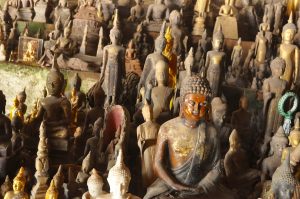 The Pak Ou Caves are home to hundreds of Buddhas of every shape and size. They sit, perched, on any ledge that will house them. Some were quite roughly crafted while others were elaborate and ornate. Venturing up another set of stone steps, we went to see the higher cave. This cave was quite dark, so I illuminated my way with my phone. It was disappointing as there were not many statues within. I had been to a similar site in Sri Lanka twelve months earlier, which was far more dramatic, with a great many more statues of Buddha.
The Pak Ou Caves are home to hundreds of Buddhas of every shape and size. They sit, perched, on any ledge that will house them. Some were quite roughly crafted while others were elaborate and ornate. Venturing up another set of stone steps, we went to see the higher cave. This cave was quite dark, so I illuminated my way with my phone. It was disappointing as there were not many statues within. I had been to a similar site in Sri Lanka twelve months earlier, which was far more dramatic, with a great many more statues of Buddha.
Looking out across the river, a number of elephants roamed around on the opposite shore, brought down by their mahouts and some tourists for a bath in the river.
We climbed aboard our boat, which took us across to the other side, upstream of the elephants to a riverside restaurant perched high, overlooking the Mekong and also the tributary, Ou River, that cuts deep into the limestone cliff it skirts by. It was a stunning location for lunch and we felt very privileged to be there.
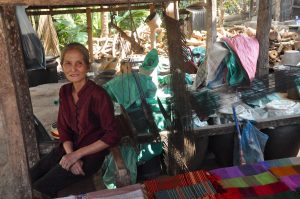 After lunch we took a diagonal route back across the river to the village of Ban Xang Hay. I guess this is a model village set up to serve tourists. It is clean and tidy, and every house has a loom producing brightly coloured cloths and scarves. One or two houses have stills producing some very strong Lao whisky made with rice. We tried some and as I did not go blind I parted with a couple of dollars and bought a small bottle to take home. It may be a false village, but it had a very nice atmosphere. The people were very welcoming, friendly without being at all pushy to sell their produce.
After lunch we took a diagonal route back across the river to the village of Ban Xang Hay. I guess this is a model village set up to serve tourists. It is clean and tidy, and every house has a loom producing brightly coloured cloths and scarves. One or two houses have stills producing some very strong Lao whisky made with rice. We tried some and as I did not go blind I parted with a couple of dollars and bought a small bottle to take home. It may be a false village, but it had a very nice atmosphere. The people were very welcoming, friendly without being at all pushy to sell their produce.
Having satisfied our urge to spend some money, to have some banter with the local people, although their English was quite limited, we returned to our boat and sped our way downstream back to Luang Prabang. It was a really enjoyable outing.
Once back I trawled the streets to find a restaurant for that night and also for our last night before we returned home. After some difficulty, I found one that could cater for us, Tamarind, and I found quite a special one for our last night party.
The next morning, I rose early again to watch the monks process through the streets. The same children were out with their cardboard boxes. If anything, the behaviour of some onlookers was even worse. It is only a matter of time before somebody says, “enough is enough.”
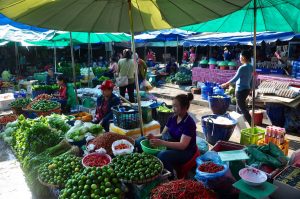 Our minibuses, later that morning, collected us and first took us to Talad Phosy market. Here, there were stalls of fresh produce, homeware, fish and meat. It is the place that all locals go to for their shopping. There was an abundance of vegetables, many of which were unfamiliar to me, brought in from outlying villages. They were beautifully displayed, and the women sat amongst them and chatted constantly with their neighbours while waiting for a customer. Other stalls had large bowls of rice piled like cones of varying shades of off-white, depending on the varieties of rice for sale. Perhaps, the most interesting, but totally un appetising, were the dried rats and squirrels that clearly have an appeal for the locals. There’s no meat on them, so what their value is, I fail to understand.
Our minibuses, later that morning, collected us and first took us to Talad Phosy market. Here, there were stalls of fresh produce, homeware, fish and meat. It is the place that all locals go to for their shopping. There was an abundance of vegetables, many of which were unfamiliar to me, brought in from outlying villages. They were beautifully displayed, and the women sat amongst them and chatted constantly with their neighbours while waiting for a customer. Other stalls had large bowls of rice piled like cones of varying shades of off-white, depending on the varieties of rice for sale. Perhaps, the most interesting, but totally un appetising, were the dried rats and squirrels that clearly have an appeal for the locals. There’s no meat on them, so what their value is, I fail to understand.
The fish and meat stalls were far less attractive to look at but were, nonetheless, interesting to view, if you had the stomach for it. Great galvanised bowls were crammed with live fish, which, one by one, were taken out, hit on the head and gutted. Water flowed everywhere. The meat was no better, with huge carcases being cut up into smaller cuts of meat. I like meat but I’m not sure that I want its processing on public view. What we were seeing were things that take place behind the scenes back home.
Next on our journey, we visited a roadside cotton weaver. There we saw the cotton seeds gently crushed to produce a little ball of cotton. This was then processed on a very basic, homemade bit of kit into a thread for weaving. The visit was the prelude to crossing the road to walk around a narrow path through the village. All the way around were stalls and at each stall there were children dressed in brightly coloured local ethnic costume trying to sell us their produce. It was horrible, so unlike the village we visited by the river yesterday. These children were being exploited by their parents and every stall we passed a child would say, “Two for a dollar.” None of us stopped to look or showed any interest in what they were selling and I, for one, kept my camera away.
Towards the end of the village we came across music and chanting. Curious, I peered in through the open door to see a shaman in black robes standing on a plank of wood, bouncing ritualistically in front of a makeshift altar while he performed an exorcism. He seemed to be in a trance and had to be supported to stop him from falling over. It made me feel slightly uncomfortable that I was watching but, at the same time, curious.
Our main destination of the day were the Tat Kuang Si Waterfalls, a series of falls with attractive pools below each one. Before we reached the falls, we walked through the Tat Kuang Si Bear Reserve, a sanctuary for bears rescued from poachers. There were about eight on show in their large enclosure and they all looked well cared for. It was fascinating watching them from such a close position and the see how they interacted with each other.
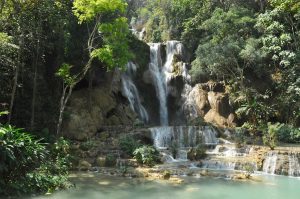 Continuing, we came to the first fall with its azure, blue pool surrounded by mature trees. Each fall we came to led to another pool above and another fall. There must have been about a dozen small waterfalls culminating in an impressive 25m fall at the top. The pools looked very attractive and there were several brave souls who were not put off by the cold water. Although I had my kit with me, I decided quite early on that I wasn’t going to venture into the water. I was put off by the crowds. This is clearly a very popular spot. It must be, for once you have been on the Mekong and visited a few temples, there is not a lot else in Luang Prabang, so everybody comes to the falls.
Continuing, we came to the first fall with its azure, blue pool surrounded by mature trees. Each fall we came to led to another pool above and another fall. There must have been about a dozen small waterfalls culminating in an impressive 25m fall at the top. The pools looked very attractive and there were several brave souls who were not put off by the cold water. Although I had my kit with me, I decided quite early on that I wasn’t going to venture into the water. I was put off by the crowds. This is clearly a very popular spot. It must be, for once you have been on the Mekong and visited a few temples, there is not a lot else in Luang Prabang, so everybody comes to the falls.
A picnic lunch was brought to us but it was not the best meal we had on this trip.
On the way back to Luang Prabang, we called in to an elephant sanctuary. Again, I have reservations about the welfare of the elephants, the length of time they spend chained to a post. I don’t like to see them repetitively swaying as it can be a sign that they are unhappy. There was a very friendly baby elephant but I’m sure it was more interested in the food people could give it rather than the person themselves.
That evening we went out to Dyen Sabai, a restaurant overlooking the Nam Khan River, on the opposite side to the main town. In order to get there, we had to pay 5000 Riel each to cross a bamboo bridge over the river. A little tube of lights illuminates the bridge at night. The charge is made to give them the resources to build a new bridge each year flowing the rainy season, during which the turbulent waters of the river carry the bridge away. Seated on a terrace above the river we had a fabulous meal, a fitting last night’s celebration.
Our last day was upon us. Phai met us after breakfast. The minibuses took us round the corner so that we could climb Phousi Hill, offering an excellent vantage point overlooking the town. Climbing the 329 steps to the top, we then had to wait for the Chinese to finish taking their multiple posed pictures before we could get a look in. At the top is the stupa of That Chomsi. There is also the remnant of an anti-aircraft gun, left over from the war. Descending by a different route, we then visited the temples of Wat Visoun, Wat Aham and Wat Xiengthong. While these were very attractive our minds were already beginning to focus on the journey ahead and I, for one, don’t think I got the most out of the visits. Phai was not that animated in his delivery of information, which did not help to maintain interest.
After returning to the hotel for a final clean up, we went to lunch in a lovely terraced restaurant overlooking the Mekong, prior to going to the airport for our flight to Hanoi and onward connection to the UK.
Laos is a lovely country and I can contemplate returning with a view to doing some trekking in the very attractive mountains, perhaps combining it with a trek in North Vietnam. I will have to look into it. We had crammed in a great deal in our three weeks but had really only scratched the surface of all three countries. There is a lot more to see and do, I am sure.
We had been well looked after throughout by our guides and I was also very impressed with the way everything ran smoothly. We had had few, if any issues. The group behaved itself! Only Pauline gave us a bit of a scare when she slipped off the path during the trek. Mike banged his head and also broke his camera when he stumbled in the cave at Halong Bay. How he kept his calm in such circumstances is remarkable. I know I would not have been happy if I had broken my camera. I cannot speak highly enough about the organisation of Asia Aventura and would recommend them to anybody planning to visit Indochina. If I do go back one day, I will definitely be getting in touch with them.
Thank you to all those who made this trip so successful and thank you to the twenty-two friends who came on it, for their excellent company and good cheer. Memories to treasure!

